Contributory members are able to log private notes and comments about each site
Sites Anne T has logged. View this log as a table or view the most recent logs from everyone
St Milburga's Well (Stoke St Milborough)
Trip No.169 Entry No.3 Date Added: 9th Aug 2021
Site Type: Holy Well or Sacred Spring
Country: England (Shropshire)
Visited: Yes on 15th Jul 2021. My rating: Condition 3 Ambience 3 Access 4
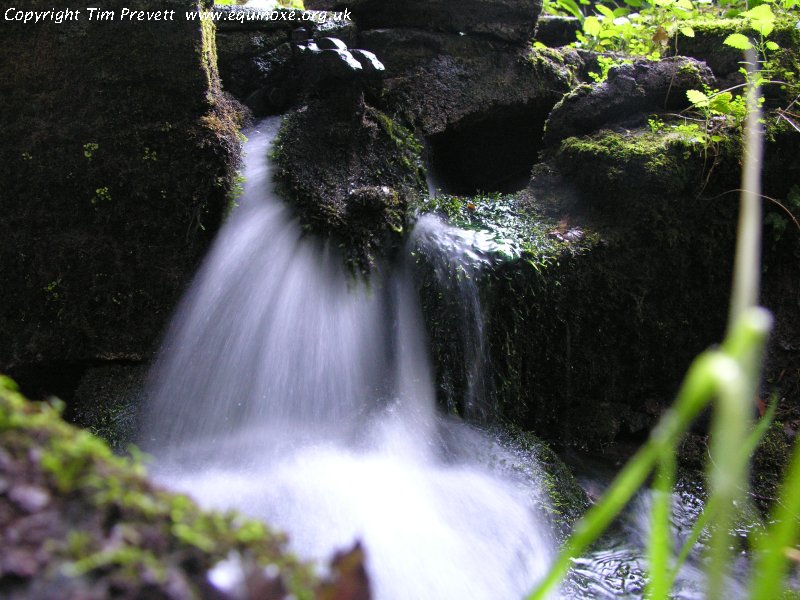
St Milburga's Well (Stoke St Milborough) submitted by TimPrevett on 23rd Sep 2007. The superlative St Milburga's Well at Stoke St Milborough. One of the best I have visited. It is situated in its own enclosure to the immediate adjacent west of the road which arcs to the east of the village.
The flow is the strongest I have observed on any holy well, coming through a pipe at the bottom of a flight of steps. A standpipe stands outside the enclosure, and with a turn of the knob, yields water.
Pay attention to the latch on the gate and head on the handrail, too.
(View photo, vote or add a comment)
Log Text: St Milburga's Well, Stoke St Milborough: We visited the church first of all, and whilst some of the church dates from the 13th century, there was little of this in evidence, the fabric having been restored in Victorian times. The church had been left open, so we looked inside, but not much of note, apart from the lovely geese (I thought they were ducks until I saw the official records) carved into the top of the wooden door into the base of the tower at the west end.
Not having a map for this area, we thought the holy well might be near to the church, but thankfully bumped into the church warden as we exited the church. He was carrying a large wooden stake and hammer, so I joked with him "are you hunting vampires?". It turned out he was marking out a burial plot for a recently deceased villager.
He directed us to the well, but told us that "thanks to the water company, there's very little left of the well". Coming out of the churchyard, we headed south on the minor road, then turned left and headed up the hill, following the road round to the left as it levelled off. Just round this bend, there was a gate into the well enclosure. Steps led down to the well head, which still exists, together with a small well pool and a lively outflow into a stream which heads westwards, back towards the church.
A very peaceful spot. Just a shame about the modern domestic water apparatus next to the well.
St Mungo's Church
Date Added: 9th Jul 2014
Site Type: Ancient Cross
Country: England (Northumberland)
Visited: Yes on 9th Jul 2014. My rating: Condition 3 Ambience 3 Access 5
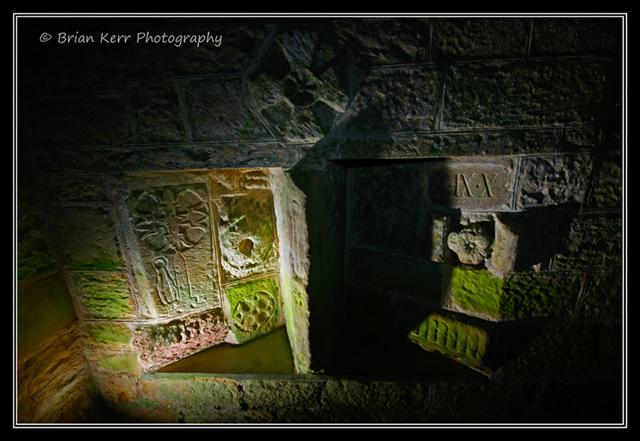
St Mungo's Church submitted by wolfnighthunter on 7th Dec 2008. Christian Cross built into the walls of St Mungo's Church, Simonburn, Northumberland
(View photo, vote or add a comment)
Log Text: I'd read about the hog's-back tombstone located in this church, and as Simonburn is only 20 miles away from our house, took advantage of the sunshine to go and explore. By absolute chance, I happened to arrive at the same time as a small coach party who had booked an organised tour with the vicar, so took myself off to the Old Post Office nearby (the only tea shop in this small hamlet) to have lunch.
Whilst the site of the church is very old, there are only a few small parts of the stone 13th century structure visible; the rest is 18th and 19th century, although if you look hard enough (and use the visitor notes available in the church) it's possible to spot some old gems of tombstones and other features built into the current fabric of the building.
The remains of the hogs-back tomb is built into the east wall of the porch, placed vertically in the centre of a display of other interesting artefacts, including (quoting from the visitor notes here!): parts of a medieval table-tomb with shears on; parts of two 13th and 14th century tomb covers; in the left and right hand corners examples of Anglian or Roman champfered impost moulding; a piece of double roll moulding with rosettes; part of the original sundial; part of a coat of arms from a medieval tomb and what is purported to be the central boss of the stone cross on the opposite west wall (Note that when you turn round to look at this said stone cross shaft, it has been clearly cut in half at some point).
Above this group there is also the remains of a stone cross.
Even though only a small portion of the hog's back tombstone remains, it is impressive, which miniature roof tiles clearly visible on both sides. The visitor notes say that the tombstone was reused in medieval times, having shears and three rosettes carved on the roof-ridge.
On a previous visit to Simonside recently, we went in search of the old castle (not much remains, and it's apparently a folly anyway), plus an old well near the river (which we couldn't find).
There is parking at the tea shop, or off the road to the left hand side of the church as you enter the village.
St Mungo's Church (Bromfield)
Trip No.81 Entry No.1 Date Added: 15th Aug 2018
Site Type: Ancient Cross
Country: England (Cumbria)
Visited: Yes on 9th Jul 2018. My rating: Condition 3 Ambience 4 Access 4

St Mungo's Church (Bromfield) submitted by Anne T on 10th Jul 2018. The dark red semi-circular stone is (the remains of) AS Corpus Bromfield 04, a 10th century hogback, as seen from the inside of the south porch. Located above the main door of the church, we stood for ages trying to make out the original hogback. The wavy edge at the top of this dark red sandstone is the only clue. According to the AS Corpus photos, the hogback can be better seen from inside the church, but the church was locked, so we were unable to see.
(View photo, vote or add a comment)
Log Text: Hogback and ancient crosses at St. Mungo's Church, Bromfield: Our first stop of the day. This is clearly an ancient village.
The church was locked, so the only stone we could see was in the porch – AS Corpus Bromfield 04. From the Corpus image, the top of the hogback looks clearer from the inside of the church, but of course we couldn’t get in.
After walking back from the well, I stopped to look at the hideous memorial in the southern part of the churchyard and noticed that it was built on what looked like the base of an old village/medieval cross. I haven’t been able to find anything out about this – it’s not mentioned in any literature I’ve currently come across – but suddenly it became more interesting!
We did try and find High Aketon Farm to see AS Corpus Bromfield 03, but couldn’t find it on the paper OS map and an internet search pulled up nothing. We decided to move on to the next location.
I’m going to try and contact the vicar to see if we can arrange entry into the church for sometime in mid-August.
St Mungo's Church (Bromfield)
Trip No.91 Entry No.1 Date Added: 15th Aug 2018
Site Type: Ancient Cross
Country: England (Cumbria)
Visited: Yes on 14th Aug 2018. My rating: Condition 3 Ambience 4 Access 4

St Mungo's Church (Bromfield) submitted by Anne T on 10th Jul 2018. The dark red semi-circular stone is (the remains of) AS Corpus Bromfield 04, a 10th century hogback, as seen from the inside of the south porch. Located above the main door of the church, we stood for ages trying to make out the original hogback. The wavy edge at the top of this dark red sandstone is the only clue. According to the AS Corpus photos, the hogback can be better seen from inside the church, but the church was locked, so we were unable to see.
(View photo, vote or add a comment)
Log Text: St Mungo's Church, Bromfield: We'd arranged with the church warden for the church to be left open for us for an hour or so this morning, so this was our first stop on a 'five church stop' tour. We were looking forward to finding cross head and cross shaft fragments, and to being able to see the reverse side of the hogback stone above the doorway.
Whilst it looks quite daunting from the outside, the inside of the church is lovely, with some unique features, such as unusual corbels and the chancel arch, which is 'transitional between Norman and Gothic styles'.
I found the cemented remains of the cross head cemeted to the west end of the north aisle, and had to remove umbrellas and a carpet sweeper to see it. It was very cobwebby, and looked sadly neglected.
AS Corpus Bromfield 02 was in two pieces. There was a collection of old stones in the north transept, and we needed to move a low bench and a collection of chairs to be able to see this.
The hogback from the other side (inside the church) was much more convincing, and there was also a consecration cross on the right hand door jamb of the south door. Well worth returning to see.
St Mungo's Dearham
Trip No.91 Entry No.4 Date Added: 16th Aug 2018
Site Type: Ancient Cross
Country: England (Cumbria)
Visited: Yes on 14th Aug 2018. My rating: Condition 3 Ambience 4 Access 5
St Mungo's Dearham submitted by coin on 29th Mar 2017. The Viking Cross at Dearham
(View photo, vote or add a comment)
Log Text: St Mungo's Church, Dearham: AS Corpus Dearham 03 and The Adam Stone: This was a return visit. pre-arranged with the lovely Reverend Mary, who drove from Crosscanonby to very kindly unlock the door of the vestry to show us AS Corpus Dearham 03, part of a cross-head.
We also saw the Adam Stone. Mary moved the knitted figures of Jesus and Peter and invited me to climb on the pew to get a better photograph. We felt so welcome, we didn’t really want to leave!
St Mungo's Dearham
Trip No.81 Entry No.5 Date Added: 16th Aug 2018
Site Type: Ancient Cross
Country: England (Cumbria)
Visited: Yes on 9th Jul 2018. My rating: Condition 3 Ambience 4 Access 5
St Mungo's Dearham submitted by coin on 29th Mar 2017. The Viking Cross at Dearham
(View photo, vote or add a comment)
Log Text: Ancient Crosses and a Norman font, St Mungo's Church, Dearham: After having been to two other churches which had been firmly locked, this church was, thankfully open and very welcoming.
The church was packed full of knitted scenes from the bible, jewellery and books. We missed the Adam Stone, but are going back on 14th August, and have asked for permission to get into the vestry to see AS Corpus Dearham 03, a fragment of a wheel headed cross built into the wall.
We had to move quite a few items from the west window to photograph AS Corpus Dearham 02, and it took us ages to get everything back!
The Norman font, apparently carved from the cushion capital of a column, was really interesting.
There was no church guide book, although there was a postcard (30p) and a display board, which I took a few photos of.
The first notes on the display board say: “There can be no doubt that Dearham had a church during the Dark Ages, following the withdrawal of Roman Forces from Britain. Many pre-Norman sculptured stones displayed in the present church provide evidence that Christianity was prevalent during Anglo Saxon and Viking times. The Reverend William Slater Calverley was vicar of Dearham from 1877 until 1885 and was responsible for uncovering and displaying many of these stones. He worked tirelessly on restoring the church to much of the originality as possible during his period of incumbency. In 1880 it was recorded that he did not know to whom the church was dedicated, the original dedication having been lost. It was rededicated in 1935, as a result of the inspiration of the Reverend Canon Malcolm D. Grieve, to St. Mungo, a Scottish saint whose real name was St. Kentigern. In 1937 Canon Grieve was also responsible for the addition inside the church building, of a side chapel dedicated to the Holy Name. It stands at the east end of the north aisle.”
There is a section on the display called: “A brief look at the history of St. Mungo’s. It is believed that the original stone church dating back to the early 1100s was about 48 feet long in the shape of a long, low tunnel. During the Norman period parts were added and extended later in the Early English period. The tower was added probably early 14th century. The porch was also an addition to the original building covering the Norman doorway. The north aisle was a completely new addition during the 1882 restoration when Mr. Calverley enlarged the church. The vestry, at the east end, is an extension to the north aisle, the date being cut into the pillar of an arch. Built in the north wall of the vestry is the head of the “Kenneth Cross”. It was found near the east end of the church and built into the vestry wall curing restoration. The stained glass window behind the altar was given by Mr. John Wilson of Dearham and built in at the time of the 1882 restoration. The bell, which weights almost half a ton, was given by Colonel Sewell, whose family were seated at Brandlingill end of Hayborough. The ancient windows, dating back probably to 1150 were removed during the 1815 restoration and sadly lost to this day! Had they been lying about in 1880 Rev. Calverley would have restorated them to their rightful place, when he in turn removed the sash windows and inserted new ones fashioned in the style of the originals.”
The display says: “The magnificent wheel head cross (Viking cross) stands 5ft 4ins high and is carved with “Yggdrasil”, the Norse tree of the universe. It stood in the churchyard until 1900 and then brought into the church and placed in front of the organ.”
Another section reads: “The treasures of the Church include two stones found during 1882 restoration work. Standing 4ft high is the Adam stone, dating from AD 900, which depicts the Fall and Redemption of Man, with Adam and Eve hand in hand above a serpent. The Kenneth Cross shows the legend of the 6th century hermit, S. Kenneth, who was lame from birth and after his baptism cast away in a coracle. He was saved from the gales, and brought up by seabirds.”
The small door leading up into the tower was open, with a very narrow set of steps leading up. Not even Andrew fancied venturing up.
St Mungo's Well (Bromfield)
Trip No.81 Entry No.2 Date Added: 22nd Jul 2018
Site Type: Holy Well or Sacred Spring
Country: England (Cumbria)
Visited: Yes on 9th Jul 2018. My rating: Condition 3 Ambience 4 Access 4
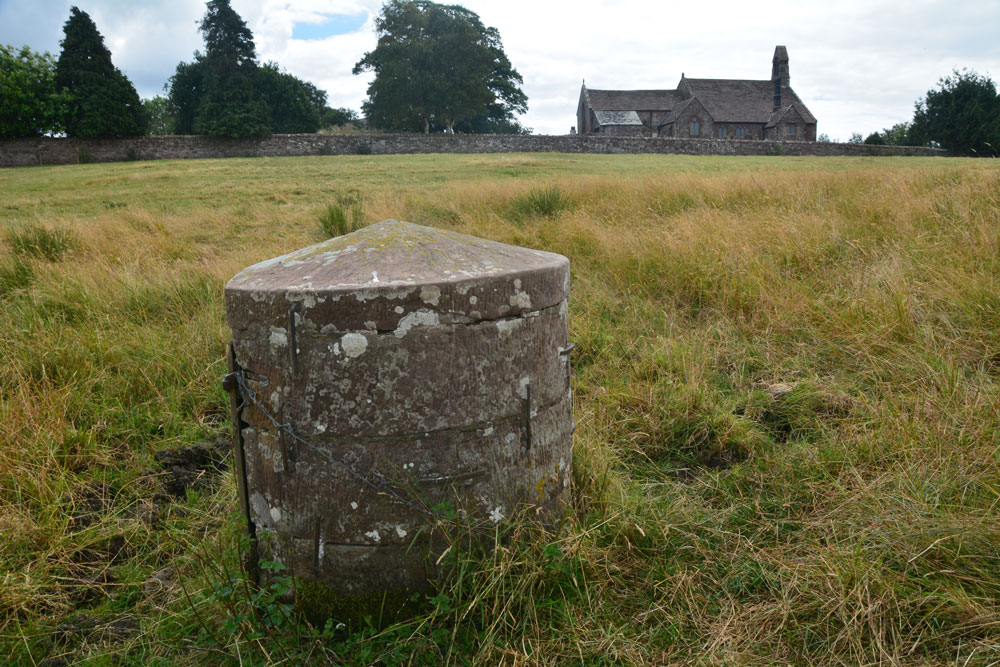
St Mungo's Well (Bromfield) submitted by Anne T on 10th Jul 2018. Standing just to the north of the well, looking back at St Kentigern's Church.
(View photo, vote or add a comment)
Log Text: St Mungo's Holy Well, Bromfield: The kissing gate from the north of the churchyard led down some sandstone gate, although the gate had been wired shut with a cable tie, so we had to clamber over. Even though there had been a long period of dry weather, parts of the ground around the well were still damp and the cattle’s hooves had sunk deep into the ground, creating tussocks and hollows. The well cavity itself was dry. In a very scenic setting, with lazy cattle (and a bull) lazing against a nearby hedgerow, looking over at us, but fortunately too hot to move.
A lovely well in a very nice, tranquil setting.
St Mungo's Well (Cumbria)
Trip No.91 Entry No.8 Date Added: 18th Aug 2018
Site Type: Holy Well or Sacred Spring
Country: England (Cumbria)
Visited: Yes on 14th Aug 2018. My rating: Condition 3 Ambience 4 Access 4
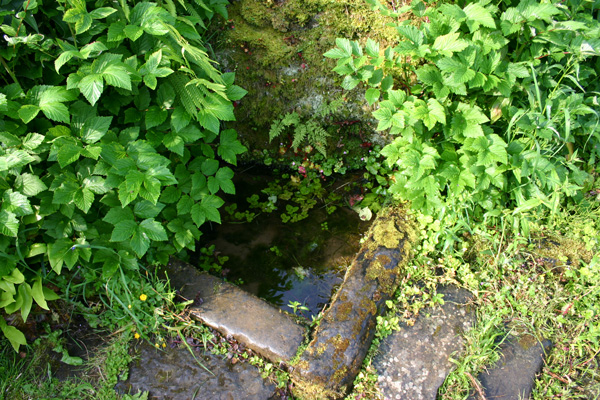
St Mungo's Well (Cumbria) submitted by ocifant on 26th Jun 2005. Looking at the various maps, the location of this well is difficult to discern. It's actually easy to find once you get to the church though.
From St Kentigern's in Caldbeck, walk through the churchyard from the road, and exit via the rear gate. Cross the footpath to the river. Immediately on entering the river path, there are a couple of steps down to the riverbank. These lead to the well.
(View photo, vote or add a comment)
Log Text: St Kentigern's Well, Caldbeck: This was our last stop of the day, and to a part of Cumbria we've never travelled through before. From St. Bridget's in Brigham, we followed the B5299 to Caldbeck village, which took us over cattle grids and moorlands, with only sheep and the occasional other car in sight.
Caldbeck is a really pretty little village, and we resolved to come back during the daytime, when the shops, church and café were open.
The well can be easily found by walking down the footpath to the west of the church, until you get to the bridge over the river. As it says in the "Holy Wells of Cumbria" booklet, turn left just before the bridge, and you immediately come to some steps down the (steep-ish) bank to the river. We heard the trickle of water down the slope, and the well basin comes into view as you look down. At the time of our visit the water missed the basin and was trickling down the rock, under the shrubbery, into the river. There was a fair flow of water coming down the bank.
We walked along the footpath along the northern side of the churchyard for about 100mand found a lovely weir with small waterfalls. It was possible to walk down to the gravel beach. A lovely spot indeed.
St Mungo's Well (Glasgow Cathedral)
Trip No.107 Entry No.1 Date Added: 7th Nov 2018
Site Type: Holy Well or Sacred Spring
Country: Scotland (North Lanarkshire)
Visited: Yes on 29th Oct 2018. My rating: Condition 3 Ambience 4 Access 4
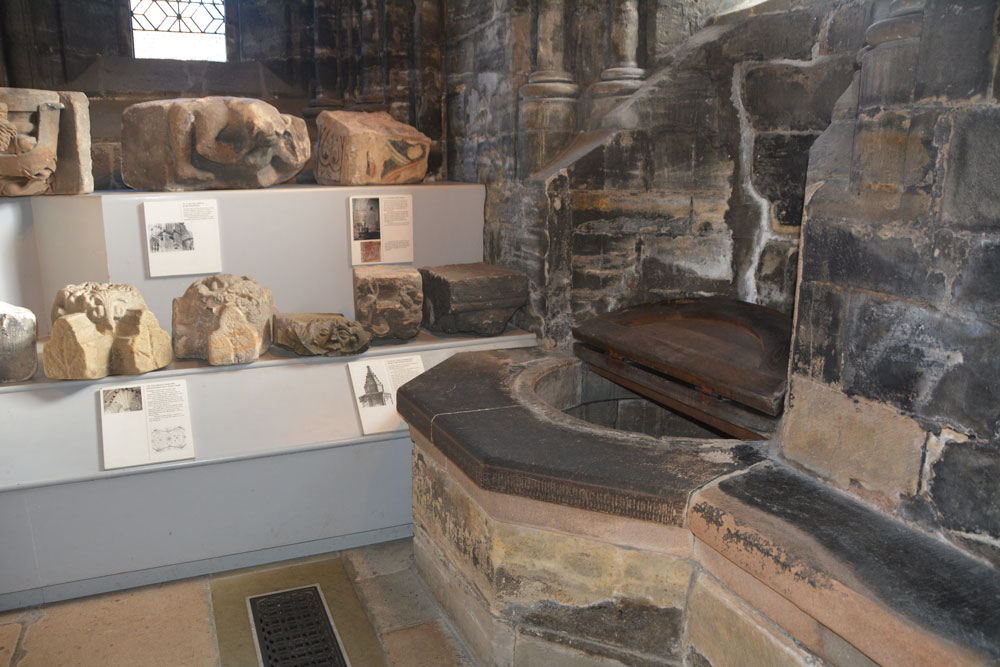
St Mungo's Well (Glasgow Cathedral) submitted by Anne T on 18th Nov 2018. St Kentigern's Holy Well in the south west corner of the crypt, with the small collection of stones from earlier cathedral buildings to its left hand side, against the east wall of the lower crypt.
(View photo, vote or add a comment)
Log Text: St Mungo's/St Kentigern's Well, Glasgow Cathedral: This Cathedral is also known as Barony Kirk, High Church, Metropolitan Kirk & St Mongo’s. The holy well is in the south eastern corner of the crypt/undercroft, next to a collection of architectural fragments and part of the arcade of the original St Mungo’s tomb.
Whilst we were there, the Cathedral guide repeatedly brought people to the well, if only for a brief look. I had to chuckle (only a little) as the well cover made looked like an old fashioned toilet seat. I’m not sure how deep the well is, even with a light, but I couldn’t see any water in it – it was either very deep or dry.
The only mention of this well in the Church’s guide book is on page 16: “In the south east corner of the crypt is St Kentigern’s Well, from which water was drawn for liturgical use. Also in that chapel is a display of carved stones, including possible fragments from the base of St Kentigern’s Shrine, and a painted stone thought to have come from the cathedral of the 1100s.
St Mungo's Well (Northumberland)
Trip No.28 Entry No.6 Date Added: 29th May 2017
Site Type: Holy Well or Sacred Spring
Country: England (Northumberland)
Visited: Yes on 28th May 2017. My rating: Condition 4 Ambience 4 Access 5
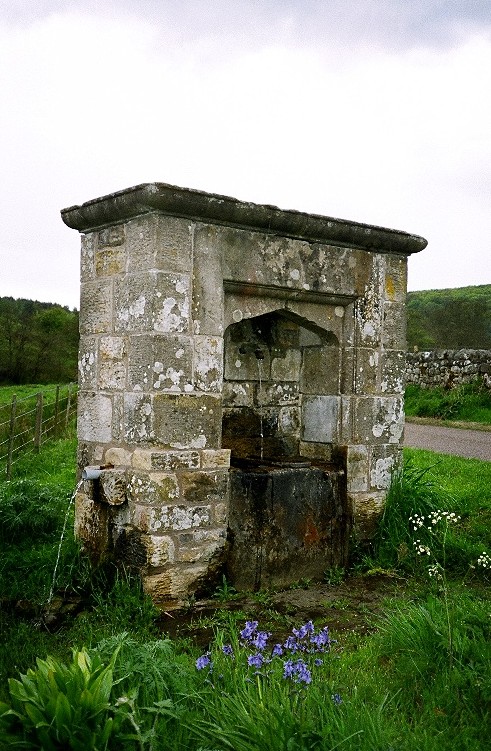
St Mungo's Well (Northumberland) submitted by KiwiBetsy on 27th Nov 2004. St Mungo's Well amidst well watered wildflowers.
(View photo, vote or add a comment)
Log Text: St. Mungo's Well, Holystone, Northumberland: We’d already visited the lovely Lady Well on 8th September 2013, but stopped to look at this one, which is at the side of the Coquet River. Sitting by the right hand side of the road just before entering the village from the Otterburn Ranges, just before the corner of the road leading up to Holystone Priory Farm and the footpath up to Lady’s Well.
The grass and weeds had grown right up to the well, although there was a small track to the well basin, showing a few other people had visited.
I did taste the water, which was clear, but didn’t taste of any particular mineral. The flow of water was strong (but not as strong as St. Cuthbert’s Well in Bellingham), indicating it might be artesian after a long spell of very dry weather in this part of the world.
I hadn’t done any research on this well before visiting, just passing by on the spur of the moment. Pastscape is dubious about this being a holy well. The shrubbery around the well hid the overflow pipe at the burn side of the structure, and I wished I had looked for the conduit at the village green. Another trip to this beautiful part of the county is called for.
St Nicholas's Cathedral (Newcastle)
Date Added: 21st Oct 2019
Site Type: Ancient Cross
Country: England (Tyne and Wear)
Visited: Yes on 6th Oct 2019. My rating: Condition 3 Ambience 4 Access 4
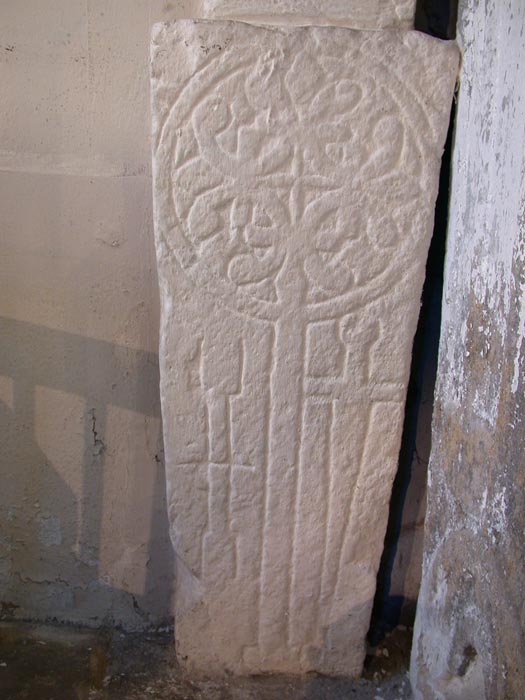
St Nicholas's Cathedral (Newcastle) submitted by nicoladidsbury on 13th Aug 2005. Elaborate Cross Slab, featuring two vertical sword shafts, similar to much smaller cross slabs found built into the fabric of the Norman wall in the ancient church at Old Ireby
(View photo, vote or add a comment)
Log Text: St Nicholas's Cathedral, Newcastle: We went to photograph the four cross slabs recorded by Ryder in St Margaret's Chapel, plus two others - one in the western of the three tomb recesses in the south wall of the south aisle; the other in the south wall of the south transept, at its eastern end.
I've since arranged to return on 16th October to photograph the slabs now stored in the vault under the south transept, although access is through a trapdoor and down a ladder!
St Nicholas's Cathedral (Newcastle)
Trip No.154 Entry No.2 Date Added: 21st Oct 2019
Site Type: Ancient Cross
Country: England (Tyne and Wear)
Visited: Yes on 16th Oct 2019. My rating: Condition 2 Ambience 2 Access 4

St Nicholas's Cathedral (Newcastle) submitted by nicoladidsbury on 13th Aug 2005. Elaborate Cross Slab, featuring two vertical sword shafts, similar to much smaller cross slabs found built into the fabric of the Norman wall in the ancient church at Old Ireby
(View photo, vote or add a comment)
Log Text: St Nicholas's Cathedral, Newcastle: I'd arranged with one of the vergers, James, to meet him at noon on 16th October to be allowed down into the vault below the south transept to see the cross slabs now stored down there.
The space is now used as a chair store, with a scissor lift at its southern end, and a larger trap door which comes up underneath the piano in the south transept.
Access was through a trap door, with a vertical ladder which started a couple of feet below the floor of the transept, so I bottled out of climbing down, and sent Andrew down with the camera.
He reported that it was really interesting seeing this space, with its barrel vaulted ceiling, but the slabs had all been stored against a wall underneath a pile of tables and other general items. What he could see looked very worn, which is presumably why they were stored down here in the first place. The stones must have deteriorated alarmingly in the 100 years or so since they were drawn by C.C. Hodges.
Disappointing. They were tuning the organ whilst we were there, which was interesting. The open trap door caused interest from other visitors to the Cathedral who wanted to look down. I volunteered to stop anyone falling down the trapdoor, so got to talk to quite a few people who were interesting in seeing this space.
St Ninian's Cave (Isle of Whithorn)
Date Added: 3rd Jul 2019
Site Type: Early Christian Sculptured Stone
Country: Scotland (Dumfries and Galloway)
Visited: Would like to visit

St Ninian's Cave (Isle of Whithorn) submitted by Anne T on 3rd Jul 2019. Submitted with the kind permission of The Whithorn Trust. This is the collection of early Christian carved stones from St Ninian's Cave, now displayed in Whithorn Museum. I only succeeded in photographing a few properly as other visitors were in the museum, and by kneeling on the floor I was blocking the path!
(View photo, vote or add a comment)
St Ninian's Church (Ninekirks)
Trip No.188 Entry No.1 Date Added: 18th Sep 2022
Site Type: Ancient Cross
Country: England (Cumbria)
Visited: Yes on 13th Sep 2022. My rating: Condition 3 Ambience 4 Access 3
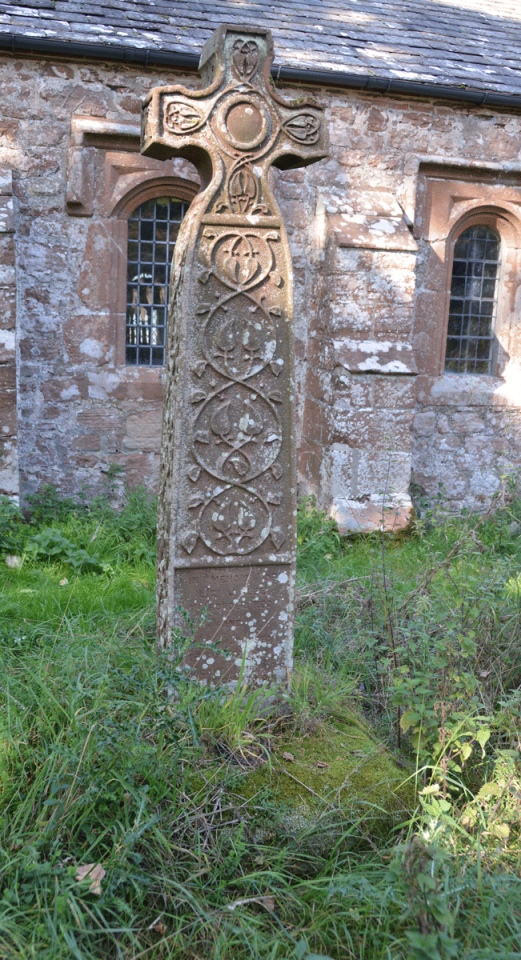
St Ninian's Church (Ninekirks) submitted by Anne T on 18th Sep 2022. Again, the cross base can hardly be seen for the tall grass covering it. Topped by a modern cross shaft and head (a modern grave marker), the cross base sits a few metres south of the nave.
(View photo, vote or add a comment)
Log Text: St Ninian's Church, Ninekirks: We parked in a very small car park which is at the start of a green lane/permissive footpath, at NY 55815 28944. This was quite tricky to spot as the entrance to the car park is small and hidden by tall grass.
The permissive footpath initially leads us a gentle slope at the northern side of a very recently ploughed field, with the River Eamont downslope to our left. The path then turns northwards, still with a steep drop down to a loop of the river, but with pasture to our right. The sheep here were so large they looked like calves.
Through the trees, we could see a large tower attached to a large building, so it came as a bit of a shock to drop down to river level and see the church was so small. It turned out that the building we could see was on top of a hill on the northern side of the river.
Whilst there was no church guide book, the notes left by the Churches Conservation Trust were very helpful.
Beautiful spot, and well worth the walk.
St Ninian's Preconquest Monastery (Ninekirks)
Trip No.188 Entry No.2 Date Added: 18th Sep 2022
Site Type: Ancient Village or Settlement
Country: England (Cumbria)
Visited: Yes on 13th Sep 2022. My rating: Condition 1 Ambience 4 Access 3
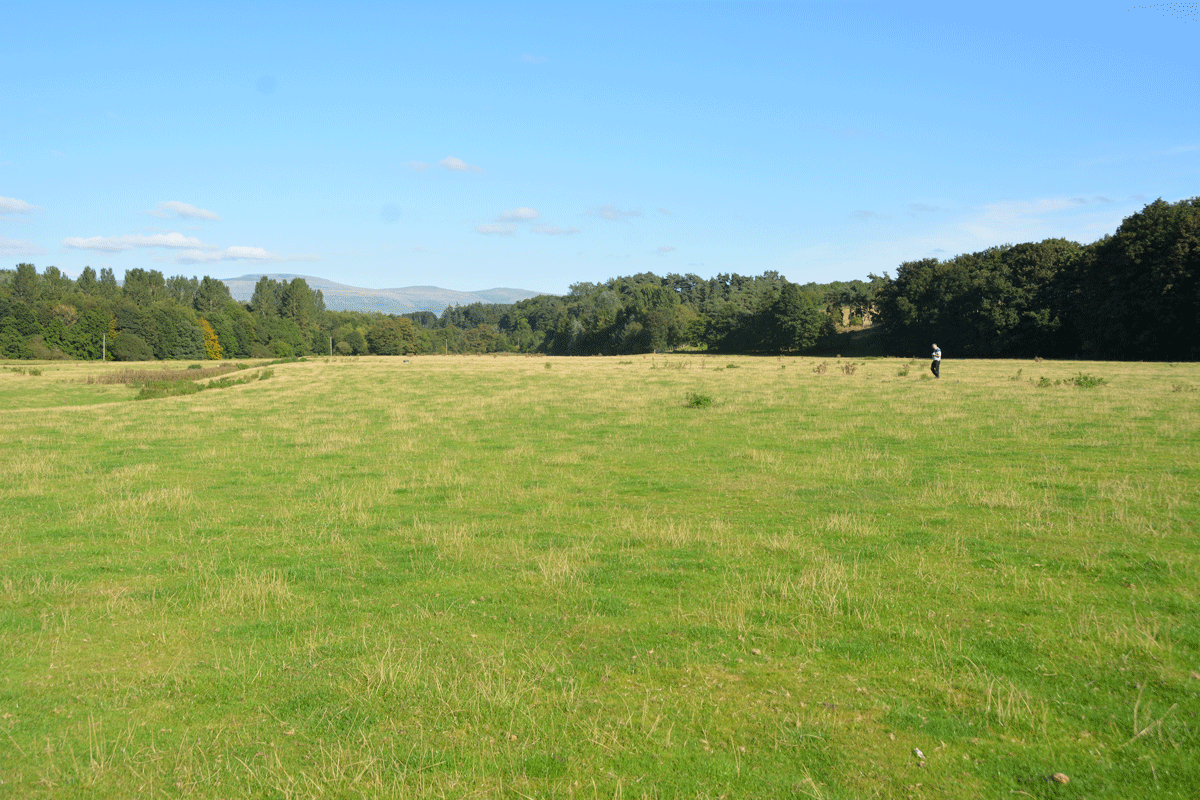
St Ninian's Preconquest Monastery (Ninekirks) submitted by Anne T on 18th Sep 2022. Husband, Andrew, stands at the grid reference given by Historic England for this site. Only a few very low 'lumps and bumps' visible in the landscape, but after a prolonged dry period, some lighter areas of grass may have identified the vague outline of foundations of buildings. Certainly some harder areas of ground (felt by our feet) seemed to run in straight lines, and could indicate stone foundations under the turf.
(View photo, vote or add a comment)
Log Text: St Ninian's Pre-Conquest Monastic Site: See visit report for St Ninian's Church (Ninekirks) for now. More details to follow.
St Ninian's Well (Brisco)
Trip No.39 Entry No.2 Date Added: 31st Jul 2019
Site Type: Holy Well or Sacred Spring
Country: England (Cumbria)
Visited: Yes on 17th Aug 2017. My rating: Condition 3 Ambience 3 Access 4
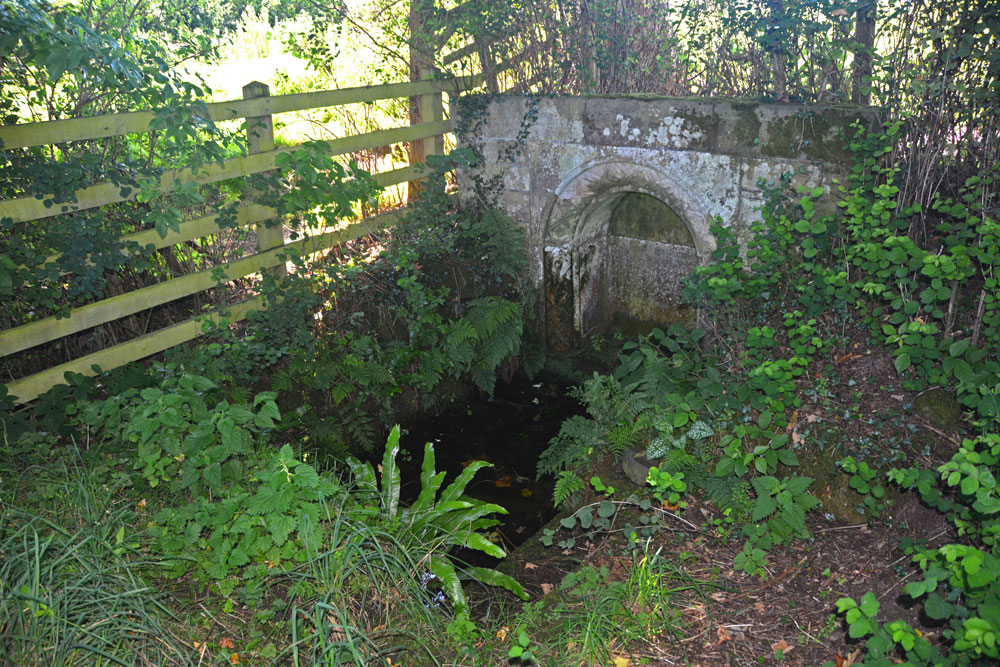
St Ninian's Well (Brisco) submitted by Anne T on 18th Aug 2017. First view of St Ninian's Well as we turned the corner of the dog-leg in the footpath.
(View photo, vote or add a comment)
Log Text: St Ninian's Well, Brisco, Cumbria: From Carlatton Demesne Standing Stone, heading back onto the A69, we took the M6 to junction 42, then the third exit towards Durdar. Brisco (Briscoe according to Pastscape) is the first turn to the right. The village is a line of houses on both sides of the road. We parked where the road widened slightly at Brisco Hall farm and walked back southwards to the footpath, which runs to the north of Well View cottage (they have a sign on the side of the house saying their drive is Elvis Presley Boulevard!), and followed the grassy lane down towards the railway line. Where the path does a right hand turn, there is a small set of stone steps. The footpath then turns north east towards the railway line, going through a gate into a field. The well is in this small enclosed area, tucked away at its south eastern end, mostly hidden by shrubs and brambles.
There is an arched well head that looks Victorian, and Pastscape and Historic England says was erected in the 1830s to 1840s. A step goes down to the well basin, in which, under the water, is a circular structure with a circular hole in its middle. In the corner of the fence facing the well is a small wooden bench, covered by brambles when we visited, but we used sticks to move these away and sit and admire this spot.
From the well, a gate leads through a fence-line down into a field of pasture below (the ground drops by 3-4 feet and there are steps down to the new ground level). This ground is wet and boggy and in line with the well head and pool is a cattle truck. A steady trickle of water comes through the bottom of the trough into a pool which has large boulders pushed around it in a partial circle, now partly destroyed. It looks like this might have been the original well pool. At the bottom of the field, the main west coast railway line runs and we watched several intercity trains and a steam train go by before returning to go into Carlisle for a late lunch then onto our next stop – a wheel-headed cross north west of Carlisle in Rockcliffe.
St Ninian's Well (Stirling)
Trip No.108 Entry No.3 Date Added: 10th Nov 2018
Site Type: Holy Well or Sacred Spring
Country: Scotland (Stirling)
Visited: Yes on 30th Oct 2018. My rating: Condition 3 Ambience 2 Access 5
St Ninian's Well (Stirling) submitted by KiwiBetsy on 16th Oct 2006. It is said that a chapel stood near the well and was still in existence in 1497 but that none of it now remains and the structure now covering the well is a wash house.
(View photo, vote or add a comment)
Log Text: St Ninian's Well, Stirling: This was just over the road from the Wellgreen Carpark, but we had difficulty in finding this well, because of its rather hidden location. Despite the GPS telling us we were only 20m away, we were unable to find it until we saw the footpath leading to Wellgreen Place at the southern side of the A811 Wellgreen Road. Shame the area is used by smokers, as the rubbish is horrible.
Opposite the well, nearer to the office block is a small set of steps leading upwards to a now very much overgrown garden area. The steps are virtually hidden under shrubbery, and although Andrew had a try at climbing up, it was very difficult and we gave up and went onto our next destination.
St Non's Chapel
Date Added: 29th Aug 2014
Site Type: Early Christian Sculptured Stone
Country: Wales (Pembrokeshire)
Visited: Yes on 22nd Aug 2014. My rating: Condition 3 Ambience 4 Access 4
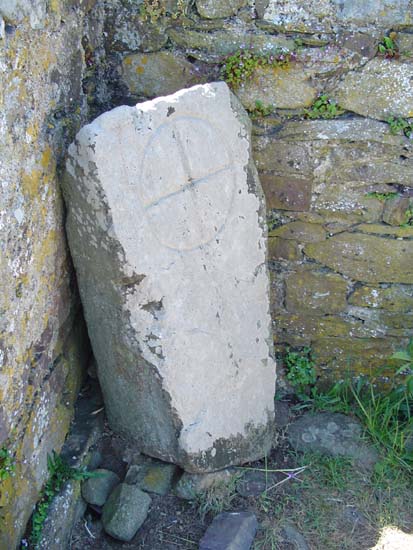
St Non's Chapel submitted by vicky on 7th Jun 2004. Within the ruined chapel of St Non's, around which are the remains of a possible stone circle, lies this inscribed stone. It is believed to date from the 7th-9th century AD and is decorated with a ring cross.
(View photo, vote or add a comment)
Log Text: St Non's Chapel, Pembrokeshire: A gate leading from between St Non’s Well (to our left) and the vault with her statue in (to our right), led into the field containing the chapel. It was a short walk to the ruined building, which is enclosed by a fence to protect it from the cattle in the field.
This chapel is very small, with an entrance to the west side. It is on a very steep site, and the walls to its southern side are composed of some impressively large stones.
Inside the chapel is a small white-painted cross, in the left hand corner as you face the sea. At its base are many offerings – tokens, tea-lights, a small memorial plaque and pebbles painted with people’s names.
Whilst we explored the stones in the field around the chapel, a Welsh family came and spent quite some time by the cross, and I wondered if they were laying their own offerings. This is certainly a superb spot to mediate and pray on a sunny day.
As we entered the field, it was apparent that there were some standing stones within the field, although I’d not seen these referred to until I logged onto the Portal when we got home. I’ve submitted some images of these along with the chapel.
St Non's Well (Pembrokeshire)
Date Added: 29th Aug 2014
Site Type: Holy Well or Sacred Spring
Country: Wales (Pembrokeshire)
Visited: Yes on 22nd Aug 2014. My rating: Condition 4 Ambience 4 Access 4
St Non's Well (Pembrokeshire) submitted by chestertourist on 27th Dec 2004. St Nons Well near St. David's.
(View photo, vote or add a comment)
Log Text: St Non's Well, Pembrokeshire: It was interesting trying to find the small road leading down to St. Non’s Chapel and Well; it turned out to be a side road off a side road, with a very, very narrow section coming out of St. David’s.
This road led down to St. Non’s Retreat Centre, with views over the sea. Just before the road reached the Retreat Centre, there was a small car park on the right hand side, with plenty of room for visitors, with only a short walk down to the well and chapel.
Approaching the well, my first view was a stone vault to the right hand side, with a white statue of a woman with her arms outstretched, and at first I thought this was St. Non’s Well. The actual well is a few steps further on to the left hand side. As we stepped down to see the source of the water, there was a continuous noise, like the well was connected to a blow hole at the bottom of the cliffs with the noise of the waves lapping at the entrance coming back up where we stood. We stood in silence, listening. “The well’s breathing!” I exclaimed. After a few more minutes, I realised that the noise came from the bullocks drinking from the small stream of water that emerged from the well into the adjacent field. Not a holy miracle after all, but it got the heart racing none-the-less.
We went onto explore St. Non’s Chapel and the standing stones in the same field, hopping onto the Coast Path (well my husband did – I couldn’t get over the stone stile in the south-western corner of the field, because of the proximity of the path to the drops down to the sea below). We watched a school of kayakers in the bay below, with blue sky and spectacular geology. I would have loved to have taken a flask of tea and just sat for a while taking this all in.
Whilst we were exploring the standing stones around the chapel, I noticed a family collecting water from the well.
St Oswald (Guiseley)
Date Added: 11th Apr 2015
Site Type: Ancient Cross
Country: England (Yorkshire (West))
Visited: Yes on 10th Apr 2015. My rating: Condition 3 Ambience 4 Access 5

St Oswald (Guiseley) submitted by rldixon on 29th Apr 2010. detail of rear of cross head
27-04-2010
(View photo, vote or add a comment)
Log Text: Anglo Saxon Cross, St. Oswald's Church, Guiseley: I had tried on several occasions to phone the vicar, the parish office and some of the church wardens to find out if the church was open during the day, even leaving messages on voice mails which weren’t returned. A couple of hours before our visit I did manage to get through to one of the churchwardens who said it was no trouble to meet us at the church at 1pm. “We always aim to please,” he told me. The church is apparently now kept locked as they caught some intruders levering brass plaques off the church wall but they always try and accommodate visitors.
I’d explained in advance that we wanted to see the Anglo Saxon cross, and expected to keep him only 10-15 minutes. But on arriving at the church he told us he was going to give us the “full church tour” – 1 hour and 40 minutes later I felt very rude when I had to make excuses as we were expected over at All Saints in Weston and had to cut the tour a little short. Make no mistake, St. Oswald’s church itself is very interesting and this gentleman knew his history; he spoke with knowledge and enthusiasm - the time flew by.
On the left hand side of the main entrance there can be seen the vague outline of one of seven original consecration crosses (now the only one remaining); the church unusually has two sanctuaries, it is also where the parents of the Brontes were married and the Patrons of the church include Trinity College Cambridge.
Entering through the porch with its now interior original Norman archway into the church, the Guiseley cross is immediately on your left hand side at the north entrance to the baptistery. Dating from the 9th century, it is very obviously an original cross shaft, mounted on a stone block with one part of a cross arm bolted/cemented on top to make it look like a full cross. The whole is blackened by soot and the churchwarden told us it had stood for many years outside in Town Gate nearby. He told us the church had considered having the cross cleaned but been advised to keep it in its current state. I found it difficult to photograph due to the bright spotlights shining down on it (had we been on our own we would have turned the lights off) and the proximity of the rear of the cross due to the stone column behind.
The churchwarden led us to what we were told was the original Saxon part of the church (now the Lady Chapel? I haven’t been able to find a floor plan of the church to double check this). He told us as a small boy he attended worship with his class from school to find two gentlemen had lifted up a slab in the floor of this part of the church; he could see a staircase leading downwards and was told there was a charnel house with many bones it in. It’s not accessible to the public and he hasn’t been down there since he saw it as a youngster.
The southern aisle is unmistakeable Norman with the original columns (although the churchwarden said there was some debate about whether or not this had been moved to accommodate a further extension at some time). There are some very notable stained glass windows in the church and one of the original box pews.
My one regret was that having to rush away to All Saints in Weston as we were very late, I wasn’t able to get any photographs of the exterior of the building. I had little time to also look at the cross. We had an invitation to phone up and arrange another visit sometime soon, and we will do that as there wasn’t enough time to take everything
